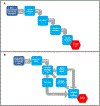Development of a Conceptual Map of Negative Consequences for Patients of Overuse of Medical Tests and Treatments
- PMID: 30105371
- PMCID: PMC7505335
- DOI: 10.1001/jamainternmed.2018.3573
Development of a Conceptual Map of Negative Consequences for Patients of Overuse of Medical Tests and Treatments
Abstract
Importance: Overuse of medical tests and treatments is an increasingly recognized problem across health systems; best practices for reducing overuse are not clear. Framing the problem in terms of the spectrum of potential patient harm is likely to be an effective strategy for clinician and patient engagement in efforts to reduce overuse, but the scope of negative consequences of overuse for patients has not been well described.
Observations: We sought to generate a comprehensive conceptual map documenting the processes through which overused tests and treatments lead to multiple domains of negative consequences for patients. For map development, an iterative consensus process was informed by structured review of the literature on overuse using PubMed and input from a panel of 6 international experts. For map verification, a systematic review was performed of case reports involving overused services, identified through literature review and manual review of relevant article collections. The conceptual map documents that overused tests and treatments and resultant downstream services generate 6 domains of negative consequences for patients: physical, psychological, social, financial, treatment burden, and dissatisfaction with health care. Negative consequences can result from overused services and from downstream services; they can also trigger further downstream services that in turn can lead to more negative consequences, in an ongoing feedback loop. Case reports on overuse confirmed the processes and domains of the conceptual map. Cases also revealed strengths and weaknesses in published communication about overuse: they were dominated by physical harms, with other negative consequences receiving far less attention.
Conclusions and relevance: This evidence-based conceptual map clarifies the processes by which overused tests and treatments result in negative consequences for patients; it also documents multiple domains of negative consequences experienced by patients. The map will be useful for facilitating comprehensive communication about overuse, estimating harms and costs associated with overused services, and informing health system efforts to reduce overuse.
Figures



References
-
- Chassin MR, Galvin RW. The urgent need to improve health care quality. Institute of Medicine National Roundtable on Health Care Quality. JAMA. 1998;280(11):1000–1005. - PubMed
-
- Rich EC, Lake TK, Valenzano CS, Maxfield MM. Paying the doctor: evidence-based decisions at the point-of-care and the role of fee-for-service incentives. J Comp Eff Res. 2013;2(3):235–247. - PubMed
-
- Berwick DM, Hackbarth AD. Eliminating waste in US health care. JAMA. 2012;307(14):1513–1516. - PubMed
Publication types
MeSH terms
Grants and funding
LinkOut - more resources
Full Text Sources
Other Literature Sources
Medical

